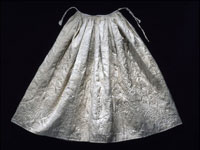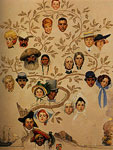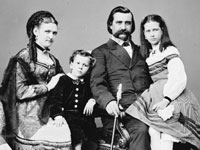Paper Trail
Tukufu Zuberi of PBS's History Detectives gives tips on how to follow a trail of primary documents to uncover reliable historical information.
Tukufu Zuberi of PBS's History Detectives gives tips on how to follow a trail of primary documents to uncover reliable historical information.
Tukufu Zuberi of PBS's History Detectives outlines methods for conducting genealogical research and finding primary sources on family history.
Author Lisa Alther talks about her work to trace her family genealogy and determine whether her ancestry includes any members of a perhaps-folkloric group of Tennessee residents called the "Melungeons." She talks about how people reconstruct their family trees, adding and omitting to create the history they wish to remember.

The person I am researching is my great X 7 Grandmother: Harriet Prudence Patterson Hall. According to various unidentified websites she was a spy for the Americans in or near Charleston, South Carolina, during the Revolutionary War. I have trouble finding any reliable and therefore quotable sources for this information. Would you please help identify anything of value in this area?
Prudence Patterson was born in 1743 (either in Wales or in County Antrim, Ireland) and emigrated to America with her parents. In 1763, she married another immigrant, John Hall, in York, South Carolina. They had eight or nine children. Their children's names were James, John, Prudence, Jennet, Margaret, William Henry, Alexander Brown, Josiah, and Major Temple.
John Hall appears on the U.S. Revolutionary War Rolls as a private in the 2nd South Carolina Regiment. He died in 1784. Prudence appears as the head of family in York in the 1790 Federal Census, residing there with her children and a slave.
Carol Berkin, a historian at Baruch College, mentions Prudence Patterson in her 2005 book, Revolutionary Mothers: Women in the Struggle for America's Independence:
"Far to the south, as the British besieged the South Carolina capital of Charleston in early 1776, Harriet Prudence Patterson Hall and three of her friends made their way past enemy soldiers surrounding the city. When the sentries topped them, Hall explained that they were on their way to purchase medicine from a Charleston apothecary. What the redcoats saw gave them little reason to be suspicious: standing before them were four well-dressed matrons, on an errand that took them into the city. The British soldiers stepped aside, giving the women permission to pass. With that, Harriet Hall walked into Charleston, an important message for the American commander safely hidden inside her petticoat."
For this information, Berkin' cites the Year Book, 2003-2004, of the Harriet Prudence Patterson Hall Chapter of the National Society of the Daughters of the American Revolution of North Little Rock, Arkansas. You might contact the Prudence Hall Chapter through their website and ask them about the source of their information. According to their website, Harriet Hetley West, a descendant of Prudence and John Hall, emigrated to Arkansas in the 1850s, and it was through her and her descendants that the North Little Rock Chapter of the DAR was formed in 1963.
Another source for more information would be the Southern Revolutionary War Institute, at the McCelvey Center in York, South Carolina, at the Museum of York County. A description on their website of their holdings of family histories related to York County, says they have a copy of The Hall Family, by Claudia Hall O'Driscoll, which may never have been published, since it doesn't show up in online library catalogs. I would guess that your ancestor appears in it, perhaps with some documentation.
It is from this book, presumably, that O'Driscoll family researchers have copied a letter from Prudence Hall's descendant Annie Farris Lumpkin to Daisy West Watkins, dated April 23, 1933, Rock Hill, South Carolina, and posted it on the Ancestry.com website:
Our notable ancestress, Harried [sic] Prudence Patterson, born in the year 1743, was of Welsh and English descent. On the maternal side she was Welsh, on the paternal, English. The Patterson family emigrated to America when Prudence was a child. The family first settled in Maryland, and later moved to Pennsylvania. She was 15 years of age when the family moved from Maryland to Pennsylvania. She rode horseback all the way and drove the cows behind the covered wagons. Later they moved to South Carolina and settled near Charles Town where she grew to young womanhood and met and married John Hall, also of an English family. John Hall was six years his wife's senior, having been born in 1737. Patterson was 20 years of age and John Hall 26 when their marriage took place in 1763.
Sometime prior to the American Revolution they left Charles Town and moved to upper South Carolina and settled in York District. Here they bought land on Little Allison Creek and built their home among a large grove of fine old trees, near a big spring of cool sparkling water, an ideal place for a residence and, strange as it may seem, this very place was destined to play an important part in the history of the American Revolution. Here a big brick store was erected, which not only served the people for miles around as a trading point, but also became the distribution point for salt. Salt was a scarce article in those days. During the Revolution, women rode horseback from as far as Camden to this place to purchase a supply of salt, which was limited to a certain amount for each family. The salt was hauled in wagons from Virginia by slaves. Here Prudence became a heroine of her day. She saved the life of a man whom the Indians had scalped and left to die. She had a number of milk cows ranging at large. One of the cows failed to come home at milking time. She mounted her horse and rode out through the dense woods to find her. She heard a moaning and groaning of someone in great distress. Being a pioneer woman of a fearless and intrepid character, she rode on till she found the man laying in water. She rode quickly back and spread the news. The man was rescued and nursed back to life. His name was John Forbess. He lived to a ripe old age and is buried in Ebenezer Cemetery.
Prudence would often walk the ten miles to attend services at Bethel Presbyterian Church, where she is now buried in Clover, South Carolina.
Prudence and two other women rode horseback to Charlestown [that is, Charleston] during the war under the guise of purchasing medicine. They were held up by the British as spies, but their story of being out to purchase medicine they were allowed to pass the British ranks. They got their medicine and returned, but not until Prudence had delivered an important message to the American Army, which she had carried sewn up in her petticoat. She had outwitted the British, and oh how they hated her. I wish I could remember the little doggerel rhyme the British made about these three woman, but I can only remember the line "Prudence Hall, Peggy Strain and Beckie McCall."
After John Hall died, Prudence moved to Union County to a place called "Sylvan Springs," a sort of summer resort. There she married a man by the name of [Robert] Harris, but soon separated from him. She ran a boarding house.
The unsourced material about Prudence Hall you see on the web is almost certainly derived from this letter.
Corroborating Prudence's wartime adventures may be difficult. A researcher from the Patterson family, however, in a comment on the Genealogy Forum website, raises two issues:
There is no record showing Prudence Hall with a first name Harriet. That appears to come from researchers of the [Hall] family, but no records (John Hall's will & estate papers nor Prudence Hall Harris' own will & estate records) indicate such a first name. … One of my Farris cousins (Annie Farris Lumpkin) was interested in family history and was a Hall descendant through Harriet Hetley West. She told a story about a Prudence Hall saving a wounded militiaman named John Forbes (my ancestor) during the Revolutionary War. But from the description of "Prudie Hall" it was a young woman (John & Prudence's daughter Prudence?), not Prudence Patterson Hall herself.
Berkin's brief account in Revolutionary Mothers places Prudence Hall's ride to Charleston during the first British siege of that city in 1776. That siege was repulsed at the Battle of Sullivan's Island on June 29th. The American forces were under the command of Major General Charles Lee, who was not at Sullivan's Island itself, but across the harbor in Charleston, exchanging dispatches with Colonel William Moultrie, who was commanding the garrison on the harbor side of Sullivan's Island.
Annie Lumpkins' letter, however, does not say when the letter-in-the-petticoat incident occurred. Nor does the letter say that the message that Prudence delivered found its way to an American "General," as do some of the unsourced sites on the web. Perhaps the Hall family history at the Southern Revolutionary War Institute or information held by the Prudence Hall Chapter of the DAR gives more detail.
At any rate, the British conducted another siege of Charleston, from April through May of 1780, which was successful. Among the more than 5,000 colonial soldiers under Major General Benjamin Lincoln who surrendered to the British on May 12th was the 2nd South Carolina Regiment, which was John Hall's unit. For more on this siege (although there is no mention of John and Prudence Hall), see Carl P. Borick's A Gallant Defense: The Siege of Charleston, 1780 (Columbia, SC: University of South Carolina Press, 2003) and Walter J. Fraser's Patriots, Pistols, and Petticoats: "Poor Sinful Charles Town" During the Revolutionary War Era (Columbia, SD: University of South Carolina Press, 2003).
The British commander of both sieges of Charleston was Sir Henry Clinton. His collected papers eventually found their way to the Clements Library at the University of Michigan. From Clinton's papers, the library has created a fascinating web exhibit, Spy Letters of the American Revolution. The exhibit has no documentation on Prudence Hall, but it draws on only a very small number of items in the collection.
A cemetery listing of graves at Bethel Presbyterian Church in Clover, South Carolina, includes the inscriptions on the gravestones for Prudence Hall, who died at 96 years of age, on August 13, 1839, and for John Hall, who died at 47 years of age, in March, 1784.
Bethel Presbyterian's webpage about its cemetery, including notes on the Revolutionary War soldiers buried there.
General Charles Lee's letters and dispatches during the 1776 siege of Charleston are collected in The Lee Papers, Vol. II, 1776-1778. Collections of the New York Historical Society, 1872.
Map of the disposition of British forces around Charleston during the 1780 siege.
Various other maps of the Charleston area during the Revolutionary War.
Images:
Detail from a map of the June 1776 British siege of Charleston, published by R. Phillips, Bridge Street, Blackfriars, London, 1806.
Petticoat, quilted cream silk, 1750-1775. Colonial Williamsburg Foundation, Williamsburg, Va.
Tukufu Zuberi of PBS's History Detectives provides a brief introduction to resources for tracing family genealogy.

Doing math seems to come more naturally to many students than doing history. After all, everyone knows you "do" math, but who's heard of "doing" history? With a little creativity we can find authentic ways for students to “do history” and learn that it's as natural as "doing" math or science!
One way for students to "do" the past as historians is to research their family’s past. Researching family history helps students create context for studying the past and helps students develop a sense of place in the present. In addition, a family history project can help foster connections with students’ guardians at home and help us, as teachers, better understand our students’ backgrounds. A student genealogy project is certainly not a new idea, but new online tools make it easier than ever to uncover family records and connect distant relatives.
Ultimately the goal of any genealogy project is to have students develop the research skills needed to complete it. Equally important is that students learn to make connections between their own family histories and the broader history of the representative era. To familiarize students with genealogy and teach students about generations, asking them to create family trees may suffice. An Internet search shows many free sites like FamilyEcho.com or Geni.com where students can create a simple family tree by entering in vital information. Students would need to interview a family member to collect information for, say, three previous generations. Students could then print their family trees from these sites. Depending on the level of your students, you may wish to take the project a step further and have them integrate family photos or artifacts into the digital family trees they create. Sites like MyHeritage.com allow users to integrate multimedia in their family trees for free.
It is also possible for students to further sharpen their historian skills by doing a little archival research. Whether that archive is in the family attic or online, students will have to use proper search techniques to find what they are looking for. A project that asks students to locate a marriage certificate, gravesite, or immigration record of a relative provides students an opportunity to explore the past as a historian might. Websites like Ancestry.com contain an abundance of information and resources including service records, ship manifests, and marriage certificates. Ancestry.com is an expensive site, but you can get two weeks of free access, enough time for students to complete their research. In addition, some public libraries have a subscription to the site.
There are a variety of ways for students to showcase their genealogical findings beyond the simple family tree diagram. Students could write narratives of their family histories (see example), which can help students learn to conduct oral history and devise appropriate questions. Students could also compose family narratives online at OurStory.com. This site allows students to link to other family members' narratives and insert relevant links or photos. A family history project also lends itself to having students create a VoiceThread with family photos, documents, and narration. With VoiceThread, other relatives could collaborate on the project as well and record their own memories or feelings.
Part of the success of projects that examine students' backgrounds comes with students feeling valued in their classroom. We must remain flexible in designing these types of projects and approach the projects with respect for diversity. We should be cognizant of students who do not live with two biological parents and recognize the variety of ways families arrived in America. So long as we keep the focus on the historical content and the historical research process, the project will be rooted in building student historical understanding rather than making students uncomfortable.
For example, a “generations project” allows students to explore genealogy while remaining sensitive to the needs of students who may not live in traditional families. With this project each student chooses a historical topic of interest and researches and reflects on how the topic has affected the lives of two individuals who have some connection to the student and are from two different previous generations. This project allows students to explore previous generations, but is not restricted to interviewing members of their families.
Whether you assign a family tree project, oral history project, or generation project, students will make meaningful connections to the past. Students will see both similarities and differences across time and will feel more connected to national and world events that influenced their relatives.
Browse Tech for Teachers to learn more about digital tools you and your students can use in genealogy presentations and other projects!

Allows genealogical searching of a number of indexes—with listings of names numbering in the hundreds of millions—created by the Mormon church to assist their members with family history research. Offers guidance and forms useful for conducting genealogical research in many places in the world and census worksheets for the U.S. covering the years 17901920, Canada for 18511901, and Ireland for 19011911.
Also includes links to hundreds of related sites accessible according to category. A good introduction to family history research.
Originally known as the Palmer House, this 10-room, turn-of-the-century bungalow home was built in 1919 by Will E. Palmer, the maternal grandfather of Alex Haley (19211992). From 1921 to 1929, and during some subsequent summers, Haley lived here with his grandparents. The front porch was often the place where young Haley heard the oral accounts of family history, including stories of Kunta Kinte, the young Mandingo man captured near his West African home. These stories inspired Haley to write about his ancestry in a book called Roots. This 1976 Pulitzer-Prize-winning novel has been translated into over 30 languages and has had great influence in stimulating the study of genealogy. Roots was adapted for an eight-part television series, which became one of the most popular programs in television history. On December 14, 1978, the Alex Haley House was listed in the National Register of Historic Places. It has attracted scholars and other visitors from around the world. Haley is buried on the grounds.
The house offers exhibits and tours.
The Tualatin Historical Society seeks to preserve and share the history of Tualatin, Oregon, settled circa 1850. To this end, the society operates the Tualtin Heritage Center, located within a 1926 Craftsmen-style church. Collection highlights include mastodon tusks and molars, Native American artifacts, an 1879 ox yoke, and Missoula flood objects. The center grounds include heritage gardens. The land was originally inhabited by the Atfalati tribe of the Kalapuya people.
The society offers exhibits, heritage gardens, and a family archive for genealogical research.
The Boone County Historical Society seeks to preserve and share the history of Boone County, Indiana. To this end, the society offers access to their headquarters, the 1893 Cragun House.
The society offers tours of the Cragun House and genealogy assistance.